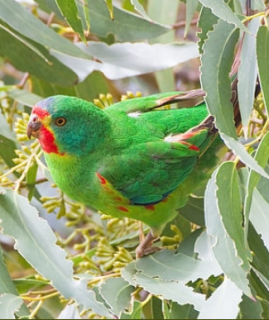Swift Parrot |
|
|
Also known as: Swift Lorikeet, Swift-flying Parakeet or Lorikeet, Red-faced Parrot or Parakeet, Red-shouldered Parrot or Parakeet
Photos
View in GalleryDid You Know?
The Swift Parrot is such a voracious feeder that there are reports of birds' plumages becoming completely matted with nectar.Academic Research
Related publications: Lathamus discolorSpecies Profile
Genus: Lathamus | Species: discolor
Size:
25cm (9.75 in)
Weight:
46-76g (1.6-2.7 oz)
Subspecies including nominate:
one
Colour Adult:
Male-in general green; face red bordered with yellow; dull red undertail coverts; dark red underwing coverts, bend of wing, and lesser wing coverts; tertial feathers on inner webs tipped with red; dull brown/red tail tipped with dark blue; varying underwing stripe. Bill brown/white. Eye orange/yellow. Female-in general duller than male; red on face less than in male, and bisected by yellow lores; varying underwing stripe.
Colour Juvenile:
In general duller than adult female; dull yellow undertail coverts wash with pale pink/red; underwing stripe white. Bill brown. Eye brown.
Call:
Calls are described as sharp and penetrating notes repeated up to 20 or 30 times in 10 seconds. While feeding emits soft, chirruping notes and a series of muscial, warbling notes from the males.
Listen NowMore Information:
Content Sources:
CITES
BirdLife International
Cornell Lab of Ornithology/Birds of the World
Parrots: A Guide to Parrots of the World, Juniper and Parr, 1998
ML Media Collection Catalogue 20558, Swift Parrot Lathamus discolor, Orenstein, Ronald, New South Wales, Australia (Taronga Zoo), Jul. 31 1970, Cornell Lab of Ornithology. Site
Parrots: Status Survey and Conservation Plan 2000-2004, Snyder, McGowan, Gilardi and Grajal, 2000.
Parrots of the World, Forshaw and Cooper, 1977. 2010 edition
Vanished and Vanishing Parrots, Forshaw, 2017.
Lexicon of Parrots, Thomas Arndt.
Parrots of the World, Forshaw, 2006.
Parrots in Aviculture, Low, 1992.
Photos
View in GalleryDid You Know?
The Swift Parrot is such a voracious feeder that there are reports of birds' plumages becoming completely matted with nectar.Academic Research
Related publications: Lathamus discolorSpecies Care
Captive Status:
Uncommon.
Longevity:
15 yrs
Housing:
Walk-in enclosure, minimum length 3m (9.8 ft).
Diet:
Limited small seed mix such as: canary, oats, safflower and a little hemp; spray millet; limited sunflower seed, dry, soaked or sprouted; sprouted pulses such as mung beans, cooked butterbeans and lentils; boiled maize; green leaves such as: Swiss chard, lettuce, sowthistle, dandelion, chickweed; vegetables such as: corn, carrot, celery, zucchini and other squash, green beans and peas in the pod; fruit such as: apple, pear, orange, cactus fruit, banana, pomegranate; nuts such as: lightly cracked hazelnuts, pecans and roasted peanuts; nectar daily soaked in sponge cake or wholegrain bread.
Enrichment:
Very active parrot so provide space and lots of branches, swings, ropes, different sized perches and ladders for climbing. Also provide lots of unsprayed, birdsafe flowering branches. Also enjoys bathing so provide overhead misters or shallow water bowls. Can be housed with others of its own species and other birds. Also provide foraging/puzzle toys and wooden and vegetable tanned leather chewable toys.
Nest Box Size:
Vertical box 7" x 7" x 14" (17.8cm x 17.8cm x 35.5cm).
Clutch Size:
4-6
Incubation Time:
20 days
Fledging Age:
6 weeks
Hatch Weight:
Not recorded.
Peak Weight:
Not recorded.
Weaning Weight:
Not recorded.
Photos
View in GalleryDid You Know?
The Swift Parrot is such a voracious feeder that there are reports of birds' plumages becoming completely matted with nectar.Academic Research
Related publications: Lathamus discolorSpecies Wild Status
World Population:
Around 2000 mature individuals.
IUCN Red List Status:
Critically Endangered
CITES Listing:
Appendix II
Threat Summary:
In Tasmania this species is affected by the clearing of Eucalyptus globulus and box-ironbark trees for agriculture, urban development, timber, sawlog production and wood chips. Also suffers high predation from sugar gliders; nestlings and adults are taken, with mortality rates for breeding females at 51%. On mainland Australia, clearance of trees for agriculture and residential development has destroyed most habitat. A population model in 2015 (Heinsohn et al.) predicted that the population will decline by an average of 87% over three generations.
Range:
SE Australia; breeds only in Tasmania, wintering in SE Queensland and E New South Wales to S Victoria and SE South Australia.
Habitat:
Found up to 1500m (4920 ft) in forest, Eucalyptus woodland, towns, grassland, open country with flowering trees and dry sclerophyll forest breeding habitat.
Wild Diet:
Feeds on pollen and nectar, especially from Eucalyptus blossoms E. sideroxylon, E. leucoxylon, E. albens, E. ovata, and E. viminalis, but also Banksia and Xanthorrhoea flowers, psyllid lerps, insect larvae, fruit, berries, and some grass seeds.
Ecology and Behaviour:
Occur in mixed flocks with Rainbow Lorikeets (Trichoglossus haematodus). Noisy and active, darting in and about trees before settling to forage. Comes to the ground only to drink. Very vocal before nighttime roost. Flocking behaviour is strong, even during the breeding season.
Clutch and Egg Size:
4-6 broadly elliptical eggs, 24.5 x 20.0mm (0.9 x 0.8 in).
Breeding Season:
October-January. Nest is high up in tree cavity; noted once in crevice in wall. Will nest semi-colonially.
Related Links:
Research: The Swift Parrot, social bees, and native insects as pollinators of Eucalyptus globus globus
Research: Winter habitat use by the endangered, migratory Swift Parrot in New South Wales
Photos
View in GalleryDid You Know?
The Swift Parrot is such a voracious feeder that there are reports of birds' plumages becoming completely matted with nectar.Academic Research
Related publications: Lathamus discolorMembers Only Resources
Please log-in now to find more research, resources and tools.
Not a Member?
Find more great information:
Gain exclusive access to 600+ pages of additional research, seminars and podcasts, specialists to ask your toughest questions, and dozens of other fun resources - when you become a WPT member.
Join Today >>

































